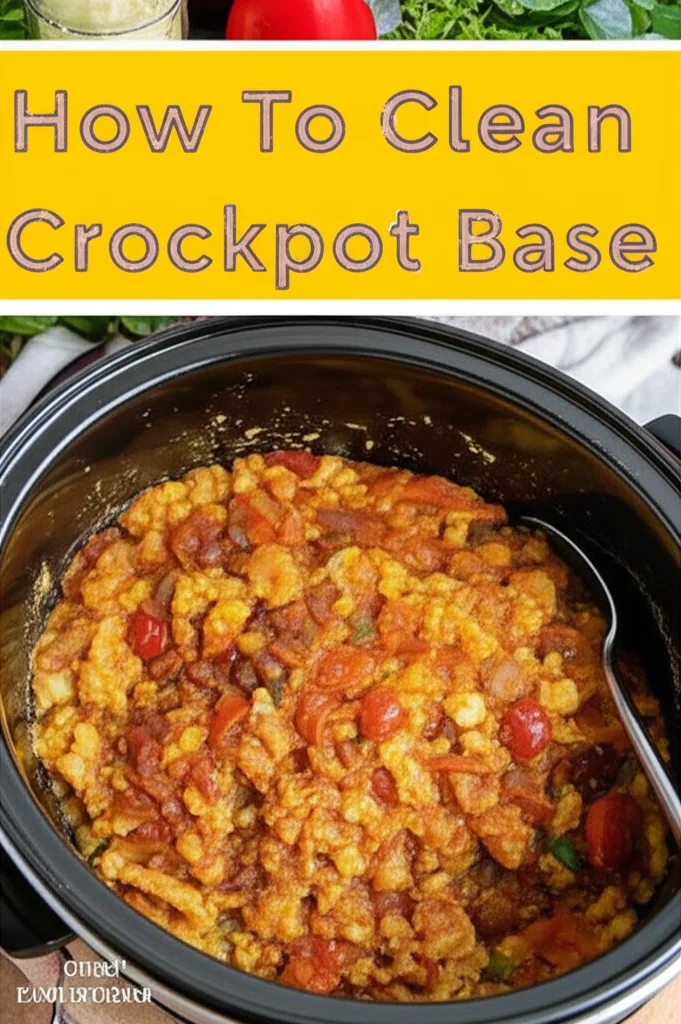· Todd Martin · Kitchen Appliances · 16 min read
How To Clean Crockpot Base

How To Clean Your Crockpot Base Safely
My crockpot is one of my favorite kitchen tools. It makes dinner easy. But over time, spills and splatters happen, especially around the base. Knowing how to clean your crockpot base is important. It keeps your appliance working well and prevents safety issues. A clean slow cooker base means healthier meals. It also helps your appliance last longer. This guide will walk you through safe and effective methods. We will cover everything from basic wipes to tackling stubborn stains. You will learn the right tools to use. You will also discover important safety tips. Get ready to give your slow cooker the care it deserves.
Takeaway:
- Always unplug your crockpot before cleaning.
- Use only non-abrasive tools and mild cleaners.
- Never submerge the electrical base in water.
- Tackle spills quickly to prevent buildup.
- Allow the base to dry completely before storage or next use.
Cleaning your crockpot base involves simple steps. First, unplug the unit. Then, wipe down the exterior with a damp cloth and mild dish soap. For stubborn spills, use a baking soda paste. Always avoid getting water into the electrical components. Ensure the base is completely dry before plugging it back in or storing it away.
Why Clean Your Crockpot Base? Longevity & Safety
Keeping your crockpot base clean is more than just about appearances. It helps ensure the appliance works well. It also keeps your home safe. Food spills and grease can build up over time. This buildup can affect the heating element’s performance. It can also create a fire hazard. A dirty crockpot base collects dust and grime. This can lead to unpleasant smells. It can also cause health concerns if not addressed. Regular cleaning prevents these problems. It keeps your slow cooker in top condition.
Health and Hygiene Benefits
Food particles and grease often splash onto the crockpot base during cooking. If you do not clean these spills, they become a breeding ground for bacteria. This is a hygiene risk. These particles can also attract pests. A clean cooking environment is essential for food safety. Cleaning the base removes these contaminants. It ensures that your meals are prepared in a healthy space. It also stops odors from forming. I always feel better knowing my appliances are spotless.
Preventing Electrical Hazards
The crockpot base contains electrical components. These include the heating element and power cord connection. Spills that seep into these areas can cause damage. They can create a short circuit. This poses a serious electrical hazard. Grease buildup can also become flammable. It increases the risk of fire. Keeping the base clean protects these vital parts. It ensures safe operation. It also prevents costly repairs or replacements. Electrical safety is always my top priority in the kitchen.
Maintaining Appliance Efficiency
A dirty base can affect how your crockpot heats food. Grease and grime act as insulators. They prevent heat from transferring properly to the ceramic insert. This makes your crockpot work harder. It uses more energy to reach the desired temperature. Overheating can damage the internal components. This shortens the lifespan of your appliance. Regular cleaning ensures efficient heat transfer. This helps your slow cooker operate at its best. It also saves you money on energy bills in the long run. Proper care ensures my crockpot always delivers perfectly cooked meals.
Gather Your Tools: Essential Crockpot Base Cleaning Supplies
Before you start cleaning your crockpot base, gather all the necessary supplies. Using the right tools makes the job easier. It also helps you avoid damaging the appliance. You likely have most of these items already in your home. I always make sure I have everything ready before I begin. This prevents interruptions during cleaning. It also ensures I can complete the task safely and effectively.
Gentle Cleaning Agents
You need cleaning agents that are effective but not harsh. Mild dish soap is your primary cleaner. It cuts through grease and food residue without being abrasive. White vinegar is another excellent option. It helps dissolve mineral deposits and deodorize. Baking soda works wonders for stubborn, dried-on messes. It creates a gentle abrasive paste. Avoid strong chemical cleaners. They can damage the surface or leave harmful residues. Natural cleaners are often best for kitchen appliances.
Non-Abrasive Cleaning Tools
Choosing the correct cleaning tools is important. You want tools that clean without scratching or damaging the base. Soft cloths or sponges are ideal for general wiping. Microfiber cloths are excellent for polishing and drying. A soft-bristled brush, like an old toothbrush, helps reach crevices. Cotton swabs are perfect for tiny, hard-to-reach spots. Avoid steel wool or abrasive scouring pads. These can scratch the finish. They can also remove important markings. Remember, gentleness is key when cleaning electronics.
Safety Gear
Cleaning electrical appliances requires safety precautions. Always wear rubber gloves. This protects your hands from cleaning solutions. It also provides an extra layer of insulation. Ensure your work area is well-lit. Make sure it is also clear of clutter. Have a dry towel ready for immediate drying. Working in a safe environment is crucial. It minimizes the risk of accidents. Safety gear helps me feel confident when cleaning.
Step-by-Step: Safely Clean Your Crockpot Base
Cleaning your crockpot base requires careful steps. Safety is the most important part of this process. Never rush when dealing with electrical appliances. Follow these instructions closely for a safe and effective clean. I always take my time to do this right. A systematic approach ensures no spot is missed.
Preparation and Safety First
Begin by ensuring your crockpot is completely cool. Never clean a hot appliance. Then, unplug the power cord from the wall outlet. This step is critical. It removes any electrical current from the unit. Next, remove the ceramic insert and lid. Wash them separately by hand or in the dishwasher. You can find more detailed instructions for cleaning the rest of your slow cooker by checking out how to clean crockpot. Place the base on a clean, dry surface. Ensure it is away from any water source. My kitchen countertop works perfectly for this task.
Tackling Light Spills and Dust
For everyday dust and minor food splatters, a simple wipe is enough. Dampen a soft cloth with warm water. Add a drop or two of mild dish soap to the cloth. Gently wipe down the exterior of the crockpot base. Pay attention to cracks and seams. These areas tend to collect dirt. Do not let water drip into the control panel or power cord entry. After wiping, use a separate clean, damp cloth to rinse off any soap residue. Finally, dry the base thoroughly with a clean, dry microfiber cloth. This step is important to prevent water marks. This routine helps maintain a clean appearance.
Dealing with Stubborn Grease and Residue
Sometimes, grease builds up or food dries onto the base. For these stubborn spots, you need a stronger approach. Mix baking soda with a small amount of water to form a paste. Apply this paste directly to the affected areas. Let it sit for 10-15 minutes. The baking soda will help lift the grime. Then, use a damp cloth or a soft-bristled brush to gently scrub the paste. Do not scrub too hard, especially on painted surfaces. For extra tough areas, you might try a cleaning solution similar to those used for heavy kitchen grease, like what you might use for how to clean your stove. Wipe away the residue with a clean, damp cloth. Repeat if necessary until the surface is clean. Finish by drying the base completely.
Tough Stains? Advanced Crockpot Base Cleaning Methods
Some stains on your crockpot base seem impossible to remove. These can be burnt-on spills or old, dried food. Standard wiping might not be enough for these messes. Do not despair. There are advanced techniques using common household items. These methods can tackle even the most stubborn grime. I have used these tricks many times with great success. They save me from replacing my appliance.
The Power of Baking Soda Paste
Baking soda is a miracle cleaner for many kitchen stains. Its mild abrasive properties make it effective. To create a strong paste, mix baking soda with just enough water to form a thick consistency. Apply this paste generously to the tough stain on your crockpot base. Let the paste sit for a minimum of 30 minutes, or even a few hours for very old stains. This allows the baking soda to break down the grime. After soaking, gently scrub the area with a soft brush or a damp cloth. The stain should lift away more easily. Wipe clean with a damp cloth and dry thoroughly. This method is safe and effective. It reminds me of the persistence needed for cleaning something like the bottom of a pan.
Vinegar Solutions for Dried Spills
White vinegar is another powerful natural cleaner. It is acidic, which helps dissolve dried food residue and hard water stains. Mix equal parts white vinegar and water in a spray bottle. Lightly spray the solution onto the dried spills on the crockpot base. Be careful not to let the liquid seep into any electrical openings. Allow the vinegar solution to sit for 10-15 minutes. This gives it time to work on the stain. Then, wipe away the softened residue with a damp cloth. Vinegar also helps to deodorize the base. It leaves it smelling fresh. Always ensure you dry the area completely after using vinegar.
Commercial Cleaners for Extreme Cases
For extremely tough stains that natural remedies cannot handle, a mild commercial kitchen degreaser might be an option. However, use these with extreme caution. Read the product label carefully. Ensure it is safe for appliance exteriors. Spray a small amount onto a cloth, not directly onto the crockpot base. Then, wipe the stained area. Never use abrasive cleaners or scourers. They can scratch or damage the finish. Always test a small, hidden area first to ensure no discoloration occurs. Rinse the area thoroughly with a damp cloth. Then dry it completely. I only resort to commercial cleaners when absolutely necessary.
Avoid These Mistakes: Crockpot Base Cleaning Don’ts
While cleaning your crockpot base, some actions can cause serious damage. Knowing what not to do is as important as knowing what to do. These mistakes can harm your appliance. They can also create safety hazards. I learned some of these lessons the hard way. Avoiding them keeps your crockpot safe and functional. Pay close attention to these warnings.
Avoiding Water Damage
The most critical rule is never to submerge the crockpot base in water. This includes placing it under a running faucet. The base contains electrical components. Water getting into these parts will cause a short circuit. It can permanently damage the heating element. It also creates a severe electric shock risk. Always use a damp cloth, not a dripping wet one. If water accidentally gets into the electrical area, do not use the crockpot. Let it air dry completely for several days. This might not even save it. Prevention is the best approach here.
Steering Clear of Harsh Chemicals
Harsh chemical cleaners, such as oven cleaners or strong abrasives, can ruin your crockpot base. These chemicals can strip the finish. They can also corrode electrical components. They may also leave behind harmful residues that could come into contact with your food. Stick to mild dish soap, baking soda, and vinegar solutions. These are effective without being destructive. A clean home is important, but safety should always come first. When I clean surfaces like how to clean countertops, I choose gentle, food-safe options too.
Never Submerging the Base
This point bears repeating because of its importance. Even if you think you are being careful, dipping the base into a sink of water is a big no-no. Water can seep into tiny cracks or openings. It can reach the internal wiring and heating coil. This can lead to electrical failure. It can also cause a fire. Always keep cleaning to the exterior surface. Use only minimal moisture. Treat the base like any other non-immersible electrical appliance. This simple rule prevents major problems. I always remember this rule for all my kitchen gadgets.
Prevent Buildup: Keep Your Slow Cooker Base Clean
Preventing messes is always easier than cleaning them. By taking a few simple steps, you can significantly reduce how often you need to deep clean your crockpot base. These preventative measures save you time and effort. They also keep your slow cooker looking new for longer. I have found these tips make a big difference in my kitchen routine. A little effort now prevents a lot of work later. This approach is part of my general strategy for how to do clean up at home.
Regular Wiping After Use
The best way to prevent stubborn buildup is to wipe your crockpot base after every use. Once the unit has cooled down and you have removed the insert, give the exterior base a quick wipe. Use a clean, damp cloth. This removes fresh splatters and drips before they dry and harden. It takes only a minute or two. This small action stops grease and food residue from accumulating. Consistent, light cleaning eliminates the need for heavy scrubbing later. It is a simple habit that makes a big impact.
Using Liners and Shields
Crockpot liners are a fantastic invention for minimizing mess. These disposable bags line the ceramic insert. They prevent food from sticking to the pot itself. More importantly, they contain spills. If something boils over, the liner helps keep it within the insert. This means less likelihood of food overflowing onto the base. You can also place a small sheet of aluminum foil around the rim of the insert, tucked under the lid. This acts as a splash guard. These simple barriers keep the base cleaner. They offer excellent protection against unexpected spills.
Proper Storage Practices
How you store your crockpot also impacts its cleanliness. Ensure the base is completely dry before storing it. Any moisture can lead to mold or mildew growth, especially in damp environments. Store the crockpot in a clean, dry cabinet or pantry. Keep it away from dusty areas. You can also place a lightweight cover over it if you store it on a shelf. This protects it from dust and airborne grease. Proper storage keeps the base looking good. It also ensures it is ready for your next meal.
When to Replace: Signs of Crockpot Base Damage
Even with the best care, appliances do not last forever. Your crockpot base can show signs of wear and tear over time. Some damage indicates it is time for a replacement. Continuing to use a damaged crockpot can be dangerous. Knowing these signs helps you make an informed decision. I always prioritize safety in my kitchen. Recognizing these warnings is important.
Signs of Electrical Damage
The most serious signs of damage involve the electrical components. If you see frayed wires on the power cord, replace the unit immediately. Sparks, smoke, or a burning smell during operation are also critical warnings. These indicate an electrical short or overheating. A crockpot that does not heat up properly or stops working mid-cycle might have a damaged heating element. Listen for unusual buzzing or popping noises. These are all signs that the internal wiring or heating components are failing. Do not try to repair electrical damage yourself. It is too risky.
Physical Deterioration
Beyond electrical issues, look for physical damage to the base itself. Cracks in the outer casing can expose internal parts. They also allow spills to seep in easily. Rust spots, especially near the power cord entry or control panel, are also concerning. These can indicate moisture damage. If the feet are missing or unstable, the crockpot could tip over. This creates a burn hazard. Any significant physical damage compromises the structural integrity of the base. It means it is time for a new appliance. A sturdy base ensures safe cooking.
Importance of Replacement
Using a damaged crockpot is a gamble. It can pose fire risks or electric shock hazards. Food might not cook evenly, leading to food safety issues. The cost of a new crockpot is far less than the potential cost of an accident. If your crockpot shows any of these serious signs, do not hesitate to replace it. Investing in a new, safe appliance gives you peace of mind. It also ensures your slow-cooked meals remain delicious and safe to eat. My family’s safety is always worth the investment.
Frequently Asked Questions
Can I submerge my crockpot base in water?
No, never submerge your crockpot base in water. The base contains electrical components. Water can damage these parts. It can cause a short circuit or an electric shock hazard. Always clean the base with a damp cloth only. This keeps water away from the wiring.
What if food spills inside the heating element area?
If food spills inside the heating element area, unplug the crockpot immediately. Do not use it until it is completely dry and clean. Use cotton swabs or a dry, soft brush to carefully remove any food particles. Allow the area to air dry for several days before plugging it back in.
How often should I clean the crockpot base?
Clean the crockpot base after every use for light wiping. For a deeper clean, address stubborn spots as soon as they appear. A comprehensive base cleaning should be done every few uses or once a month, depending on how frequently you use the appliance. Regular cleaning prevents buildup.
Are there any natural cleaners safe for the crockpot base?
Yes, natural cleaners are safe and effective. Mild dish soap mixed with water works for general cleaning. A paste made from baking soda and water tackles stubborn stains. White vinegar mixed with water is great for dried-on spills and deodorizing. Always use these sparingly and wipe dry.
What should I do if my crockpot base gets wet inside?
If your crockpot base gets wet inside, unplug it immediately. Do not use it. Turn it upside down to drain any water. Let it air dry in a warm, dry place for at least 48-72 hours. Do not attempt to use it until you are absolutely certain it is completely dry. If unsure, replace the unit.
Conclusion
Taking care of your crockpot base is simple, but vital. You now know how to clean crockpot base safely and effectively. Remember to always unplug the appliance first. Use gentle cleaning agents and non-abrasive tools. Never submerge the electrical base in water. Tackle spills quickly to prevent tough stains. Regular cleaning not only keeps your crockpot looking good. It also ensures safe and efficient operation. This extends its lifespan.
Making crockpot base cleaning a routine part of your kitchen maintenance protects your appliance and your home. My slow cooker has been a faithful helper for years thanks to regular care. By following these steps, you can keep your slow cooker ready for many more delicious meals. Keep it clean, keep it safe, and enjoy the convenience it brings.





